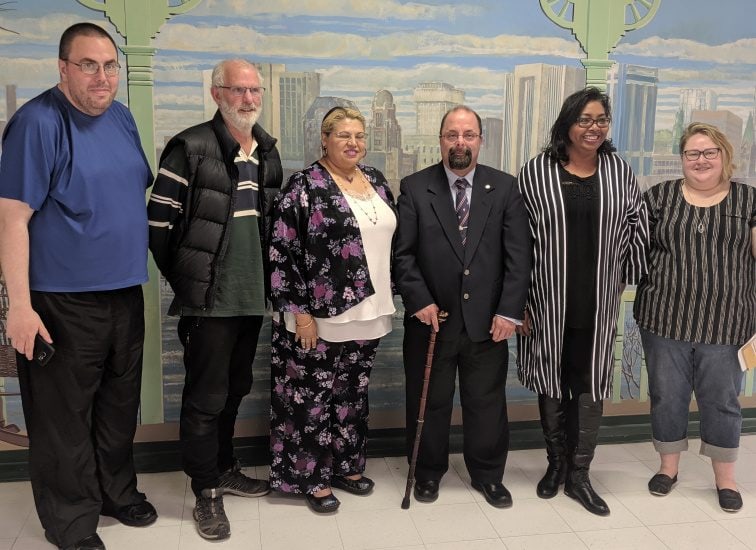KJIPUKTUK (Halifax) – One of the panellists at last night’s screening of My Week on Welfare in Dartmouth was human rights lawyer Vince Calderhead.
He talks about how the much-hyped transformation did not at all make things better for people on income assistance and his fear that special needs allowances will be next. He also tackles the subject of tactics, don’t waste your time trying to convince bureaucrats, he says.

My name is Vince Calderhead, I am a lawyer, I work here in Halifax. I enjoyed the idea of what one of the other speakers tonight referred to as being a second voice. Even though I am a lawyer now, and have been for 33 years, I too was once a first voice person, I too received social assistance, briefly.
This was in the days when assistance was provided by municipalities, and I was supported by the city of Halifax. Even though I was only along for a couple of weeks, I remember that experience as being so humiliating that it made me angry. I felt I wanted to do something about it, and I applied and was accepted and became a lawyer, and for the last 30-odd years I have been representing people in receipt of social assistance.
Tonight I want to talk about the transformation, I want to talk about the next steps of the transformation, and finally I want to speak briefly about advocacy.
The transformation means worse outcomes for everybody
First I want to talk about the transformation. Anybody who receives social assistance or follows these issues will have heard of the transformation.
Transformation is a very ambitious word that suggests dramatic and almost radical changes. To call something transformative means that it will be almost unrecognizable afterwords.
We have been hearing about the transformation for about five years now. Whenever people said that it doesn’t feel like things are getting any better the department would respond by saying, don’t worry, when the transformation comes it is going to be great.
Now we kind of know in this most recent budget what the transformation will really mean for the people on social assistance. We know what it has been like since the transformation began in 2015, and thanks to the budget we now know what things will look like in March 2020.
The one-pager I have given you will set out what the transformation will have accomplished for four sample families. We look at every single source of income for people on social assistance, and all the applicable provincial credits. I added them all together, and adjusted them for inflation.
See also: For people on income assistance there is another tunnel at the end of the tunnel
Taking into account inflation, in every single case transformation means that these people will be worse off next March than they were at the beginning, that’s the bottom line. So much for those who were told that the transformation will improve their situation.
You will see how in my footnote I quote from the department’s own Statement of Mandate. It states that the transformation will mean better outcomes for clients. Look at those numbers in red. The transformation means worse outcomes! The numbers speak for themselves.
The question is, what was the transformation really about? What was the purpose and what was accomplished?
We don’t know for sure, because they haven’t told us, but it appears to have been simply an administrative and managerial rearrangement within the department, shuffling management and changing the way caseworkers will work, in order to save the department money on employees. Saving labour expenses, while being completely indifferent to improving client standard of living. After five years that’s what we are left with.
Special needs is where the transformation effort will focus next
Let’s think about the next step of the transformation. When you go through the various handouts and presentations by department officials it looks like the next step may well be about special needs.
Those of us who have had experience with social assistance know what special needs are, they’re the add-ons. Except that from a disability rights point of view they are basic needs. For people with disabilities a special diet allowance is not an add-on, it’s basic.
Let me say just a few words about special diet allowances as they relate to people’s human rights. Many people will know about special diets. There is the basic personal allowance, and then there are special diets, which are added when requested and with a doctor’s letter. Special diets are for people whose health condition requires that they get an additional amount for their health condition, diabetes, or one of a dozen or so other conditions.
The amounts are like an extra $35 or $40, and so on. The average special diet allowance is around $80, so that is a significant amount of money.
I bring this up because the special diets represent a huge human rights problem, in two ways. First of all, these diets were introduced in 1996, that’s when the province took over the social assistance program (from the municipalities) and special diet allowances were introduced.
The basic allowance has increased 11 times since 1996 and the present, to reflect the cost of living increases. Special diets have not increased at all over that time. What does that tell us? It means the province is totally indifferent in meeting the human rights of people with disabilities, totally indifferent to the fact that it is discriminatory.
On the other hand, it is clear to me, from reading the department’s documentation, that their next move will be around special diets. What seems to be their plan is to move from a needs-based system for special needs, including special diets, to what they call an allowance-based system.
Rather than fine tuning what you need they’ll say, oh, you have certain needs, that means this is what you will get, a fixed allowance. What it means is getting away from a needs-based system to a flat rate. Given that the standard household rate has already been set, that is water under the bridge. If there is to be advocacy a good area to focus would be around special needs and special diet rates.
Talking to bureaucrats is a waste of time
Finally, let me talk about advocacy efforts. Many of us are involved in advocacy. It’s been my life’s work, whether in court or elsewhere.
What I have learned in my 30-odd years of experience with advocacy in this area, is that what doesn’t work is meeting with Community Services officials. They will listen, often politely, and offer you biscuits, and then say thank you, thanks everyone for coming. That is what typically happens, Nothing ever comes from that, because they don’t have power. It is a waste of time.
So what to do? Where are the levers, where are the pressure points?
In my view the levers are found at the political level, not at the bureaucratic level. And provincially it is more or less in the Premier’s office. That’s where all of the real decisions are made. I am urging those of you who do advocacy work to consider targeting there.
Here is a little example. A while ago someone raised a question why for single parents on assistance who receive child support that amount is clawed back dollar for dollar. You may ask, if that’s the case, why even bother getting child support? It struck the premier as arbitrary, and he was kind of shocked, and promised to change that. It was almost as if his human compassion got the better of him, and he jumped in and said, we’re going to change it.
See also: Tim Blades at the Province House rally: End the child support clawback for single mothers on welfare
And then it was changed. The lesson is, target the very top, no matter how the pitch is framed.
It does not have to be this way
Being moved by the stories in tonight’s film and by the other speakers here tonight, my closing remark is that it does not have to be this way. In fact, many years ago Nova Scotia was not as bad as it is now. When you look at the adequacy of social assistance, rates reached `the maximum adequacy in 1998. Ever since it has been going down relative to standards of living.
In Denmark a couple of years ago I wanted to talk about a poverty law course I teach at law school. I said, tell me about your course that you teach. After a few minutes the faculty at the university there said, we don’t have a course in poverty law because we don’t really have poverty.
The lesson there is that it doesn’t have to be this way. Canada is a wealthy country. The problem is not the wealth of the country, the problem is how it is distributed.

Follow BRAG on Facebook, Twitter and YouTube.
With a special thanks to our generous donors who make publication of the Nova Scotia Advocate possible.
Subscribe to the Nova Scotia Advocate weekly digest and never miss an article again. It’s free!



